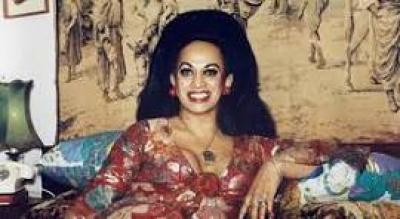Annie Goldson Film Documents Fringe Players at Hinge of Modern Times
The Age of Aquarius took its time in making landfall in Oceania. It was said that someone who missed London’s zany swinging 60’s could catch up simply by arriving in Wellington in time for the 70s which is where and when Red Mole started.
A theatrical free form group merging elements of vaudeville, the fringe, and the circus Red Mole had some early commercial success by teaming up with the undisputed Queen of the capital’s night life throughout the 1970s.
This was Carmen (pictured) who had begun life as Trevor Rupe and switched genders to headline the capital’s after hours entertainment through a mixture of courtly savvy and an instinct for what the punters really wanted.
A benign figure and sidewalk philosopher Carmen noted that the “Day people have no idea what the Night People do.”
Carmen’s scene was a natural fit for the Red Mole louche and deliberately outrageous version of the performing arts complete with the players timeless posters.
After bedding in at Carmen’s venue Red Mole which had started as an indignant in-your-face touring troupe decided it was insufficiently self-renewing, too comfortable and had better start the rigours of touring again.
Fretting about going over old ground the players now took a step which was to distinguish them from any other Antipodean group in this category at this time.
Red Mole went straight to New York arriving literally out of the blue in the heart of the Times Square and Broadway theatre district at a time when the Great White Way along with the rest of New York was in the throes of bankruptcy.
A good looking and forceful collective Red Mole started door knocking and in due course discovered a manager and sites for their gigs.
Annie Goldson’s archival footage blended with contemporary recollections of group veterans and families outlines a hard scrabble existence braced with performing stints in the seedier bars of this milieu in order to get the cash to keep Red Mole operational.
Art is a cruel mistress and there is the impression that the moment the group got a steady earner they were possessed of an urge to try something else, somewhere else.
In road-film style we follow the Red Mole group into Central America and it is now that troupe members start to question the stress and uncertainty of their life style an instability emphasised now by the pregnancy of one of the founders.
In the end the troupe ended not that far away from their point of departure back in New Zealand in Wellington’s Island Bay suburb long a haven for those of artistic sensibilities.
There followed the early and unexpected deaths of the two founders Alan Brunton and Sarah Rodwell whose daughter Ruby is on screen to retrace the troupe’s colourful path in the New York theatre district.
Ruby is drawn in with other thesp veterans to bring audiences up to date with the bitter sweet denouement of what might be described as a pioneering venture in collective theatrical touring counter culture.
The defiance of the group was picked up by one New York critic who noted its “anti-colonial” theme.
Was Red Mole transformational in a politico-performing sense?
When it started Equity was an industrial union and there was attention to quavers instead of quotas, and people still married people of the opposite sex.
By the time the Red Mole thespians finally hung up their papier mache head masks everything had changed.
Their formula of attention-getting defiance had become standardised, the norm. Everyone in politics, the media, and show business was doing it.
The film is curiously sub titled as “A Romance.”
The romance was surely between the troupe and their art because here their devotion as portrayed in the feature documentary was constant in that they hewed to it always and never falling prey to the tempting diversity of soft options taken by so many of today’s practitioners.

